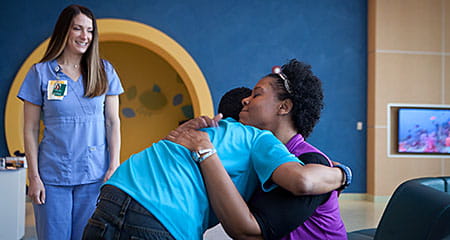Common Terms You May Hear When Your Child Receives Proton Therapy

Glossary of common terms you may hear when your child is receiving proton therapy at Cincinnati Children's:

Glossary of common terms you may hear when your child is receiving proton therapy at Cincinnati Children's:
A complex system of metal tubes that is almost as long as a football field. Magnetic fields direct the protons from the cyclotron through the beam line to the treatment room.
Sophisticated equipment that energizes the protons before they enter the beam line.
The first step in creating a customized treatment plan for your child. It involves positioning the child’s body exactly as it will be during treatment and taking computed tomography (CT) scans. These scans help the care team determine how much tissue to treat, how to avoid healthy tissue and how much radiation to deliver to the tumor.
A large metal framework that rotates around a patient during the proton radiation treatment, directing proton beams at the tumor. Most of the gantry is hidden behind the walls of the treatment vault and is not visible to the patient.
These devices help your child remain still during proton therapy. For example, our team may create a custom-made foam mold that conforms to your child’s body. Your child will lie down on this mold during treatment. If your child is being treated for a tumor in the eye, brain or head, we will create a mask for your child to wear that holds the head in place.
A type of radiation therapy that targets tumors with multiple beams of radiation at different angles and intensities. IMRT can use photon or proton radiation.
A type of cancer treatment that uses different forms of radiation to kill cancer cells by destroying their genetic code. This stops the cells’ ability to divide and grow.
The personalized, detailed plan of care for your child. This includes the number of treatments, how much radiation to give, how to position your child on the treatment table, and much more.
The room where a patient receives proton therapy. The walls of the room are built with several feet of concrete to prevent any stray proton radiation from escaping. In this way, the room is similar to a bank vault, which is where the term “treatment vault” comes from.
A “dry run” of a proton therapy session. This takes place before the first proton therapy treatment, and is an opportunity to confirm that the treatment parameters are correct. It also helps children understand what the treatment sessions will be like.
Weekly checkups with the radiation oncologist that take place when a patient is receiving proton therapy.
Pencil beam scanning is a term used to describe technology available at the newest proton therapy centers, including Cincinnati Children’s. It uses a narrow beam of protons to “paint” a tumor layer by layer. This is similar to what a 3-D printer does when it “prints” a three-dimensional object. In many cases, this allows the protons to better match the exact shape of the tumor.
Older proton therapy technology is referred to as “scattering.” This type of technology is still beneficial, but not as precise.
Particles of “electromagnetic” radiation such as X-rays, microwaves and visible light, which are used in traditional radiation therapy to treat tumors.
Tiny particles found in the nucleus of every atom. They are too small to see even with a powerful microscope. Protons are used in proton therapy to treat tumors.